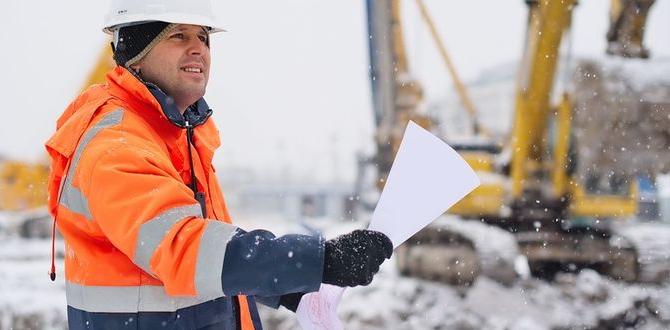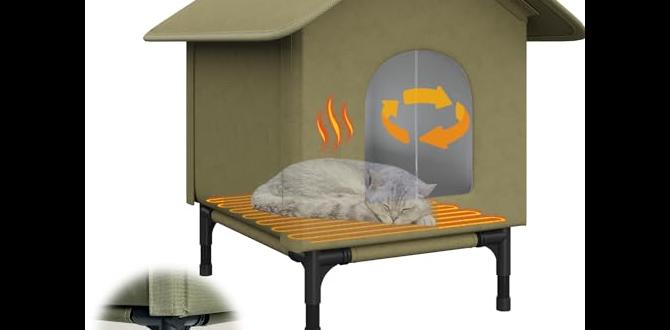As winter approaches, cold weather can pose big challenges for outdoor workers. Imagine spending hours outside in freezing temperatures, battling icy winds. Doesn’t sound fun, right? Yet many people do this every day, from construction crews to delivery drivers.
Did you know that frostbite can happen in as little as 30 minutes? That’s a cold reality! It’s crucial for outdoor workers to follow cold weather safety tips. Staying warm and safe is not just smart; it could save your life.
In this article, we will explore simple yet effective tips to protect outdoor workers from the biting cold. From dressing in layers to recognizing the signs of cold stress, these tips are easy to follow. Are you ready to learn how to work safely in winter’s chilly grip?
Cold Weather Safety Tips For Outdoor Workers: Essential Guidelines Cold Weather Can Pose Serious Risks For Outdoor Workers, Making It Vital To Ensure Safety Measures Are In Place. The Combination Of Low Temperatures, Wind Chill, And Precipitation Can Lead To Various Health Issues, Including Hypothermia And Frostbite. Here Are Some Essential Cold Weather Safety Tips To Keep Outdoor Workers Safe And Healthy While Performing Their Duties. 1. Dress In Layers Wearing Multiple Layers Of Clothing Is Essential For Trapping Heat While Still Allowing Moisture To Escape. Start With A Moisture-Wicking Base Layer, Add An Insulating Layer For Warmth, And Finish With A Waterproof And Windproof Outer Layer. Ensure That Gloves, Hats, And Scarves Are Included To Protect Extremities And Retain Body Heat. 2. Stay Hydrated Dehydration Can Occur Even In Cold Weather, So Workers Should Keep Drinking Water Throughout Their Shifts. Hot Beverages, Such As Tea Or Coffee, Can Also Help Maintain Warmth And Hydration. 3. Take Regular Breaks Outdoor Workers Should Take Scheduled Breaks In Warm, Sheltered Areas To Restore Body Temperature. This Time Can Also Be Used To Check On Colleagues And Ensure Everyone Is Coping With The Cold Conditions. 4. Monitor Weather Conditions Stay Updated On Changing Weather Forecasts And Conditions Throughout The Day. Be Prepared To Adjust Work Schedules Or Activities According To Weather Changes, Including Snow Or Extreme Wind Chill. 5. Promote A Buddy System Working In Pairs Can Help Workers Monitor Each Other For Signs Of Cold Stress, Such As Shivering, Confusion, Or Fatigue. A Buddy System Enhances Safety By Allowing Workers To Assist Each Other If Conditions Become Dangerous. 6. Recognize Cold Stress Symptoms It’S Important To Be Aware Of The Signs Of Cold Stress, Which Can Include: – **Frostbite:** Numbness And Discoloration Of Skin, Especially On Fingers, Toes, Ears, And Nose. – **Hypothermia:** Signs Include Shivering, Slurred Speech, Slow Breathing, And Confusion. If Any Of These Symptoms Occur, Workers Should Seek Medical Attention Immediately. 7. Provide Proper Training Employers Should Ensure That Outdoor Workers Receive Training On Cold Weather Hazards And Safety Protocols. Understanding How To Recognize Risks And Take Appropriate Action Can Significantly Enhance Safety. Conclusion Implementing Cold Weather Safety Tips For Outdoor Workers Is Crucial To Prevent Injuries And Maintain Health. By Following These Guidelines, Workers Can Protect Themselves Against The Dangers Of Low Temperatures While Performing Their Essential Tasks. Safety Should Always Be The Priority, Even In Challenging Weather Conditions.

Cold Weather Safety Tips for Outdoor Workers
Cold weather can be tough for outdoor workers. Stay warm and safe with these key tips. First, wear layers. This helps trap heat but allows you to cool down if needed. Keep your head and hands covered. Did you know that most body heat escapes from these areas? Also, take breaks inside to warm up. Drinking warm fluids can also help. Remember, safety comes first, even in the chill!Dressing for the Cold: Layering Techniques
Importance of layering clothing for insulation and moisture control. Recommended materials for cold weather work attire.Staying warm in cold weather is like building a cozy pizza. You need layers! First, base layers trap heat and wick moisture. Think of them as your thermal pizza dough. Next, add insulating layers, like fleece, to keep the heat in, just like a gooey layer of cheese. Finally, an outer layer, like a waterproof jacket, protects against wind and snow, much like a crispy crust. Here’s a quick guide:
| Layer Type | Materials |
|---|---|
| Base Layer | Polyester, Wool |
| Insulating Layer | Fleece, Down |
| Outer Layer | Gore-Tex, Nylon |
Remember, staying warm is all about those layers. So gear up, and don’t let the cold give you the chills!
Recognizing Signs of Cold Stress
Key symptoms of frostbite and hypothermia. How to assess your health and that of coworkers.Cold stress can sneak up on anyone, just like a sneaky squirrel. Keep an eye out for key symptoms of frostbite and hypothermia. Frostbite usually starts with cold, numb fingers, and skin that looks pale or bluish. Hypothermia, on the other hand, might make you feel unusually sleepy and confused. Check on yourself and your coworkers often. If someone is shivering or looks out of it, it’s time to take action! Remember, your health and safety come first.
| Sign | Frostbite | Hypothermia |
|---|---|---|
| Symptoms | Cold, numb skin, pale/blue color | Extreme shivering, confusion |
| Action | Seek warmth, warm affected areas | Call for help, warm up immediately |
Workplace Policies and Procedures
Guidelines for employers on cold weather safety practices. Importance of training and education for outdoor workers.Your workplace needs clear rules for outdoor workers in cold weather. Employers should set up guidelines to keep everyone safe. This includes offering warm breaks and proper gear. Training sessions teach workers how to stay safe and warm. Remember, a little knowledge can go a long way—like knowing when to wear those fluffy socks!
| Safety Practice | Description |
|---|---|
| Dress in Layers | Wearing layers traps heat. No one wants to be a popsicle! |
| Regular Breaks | Take breaks often to warm up. Hot chocolate, anyone? |
| Monitor Symptoms | Watch for signs of frostbite or hypothermia. No one wants to play doctor! |
Training is not just a nice idea; it’s a must. Workers need to know what to do in the cold. A well-trained team can avoid accidents and stay happy. After all, nobody wants to work in chilly misery!
Best Practices for Staying Warm During Work Hours
Strategies for taking breaks and rotating tasks to stay warm. Importance of hydration and nutrition in cold weather.Working in cold weather can be tough. Take breaks often to warm up. A quick hot tea or a cozy spot can do wonders. Rotate tasks to keep moving and stay active—because standing still is like being a popsicle! Hydration is key too; cold air can be dry. Drink water and munch on warm snacks to keep your energy up. Remember, “A snack a day keeps the cold blues away!”
| Tip | Description |
|---|---|
| Take Breaks | Short breaks help keep you warm; get cozy when you can! |
| Rotate Tasks | Change jobs to stay active and avoid the chill. |
| Stay Hydrated | Drink water regularly; the cold can sneak thirst up on you! |
| Eat Warm Foods | Snack on hot foods to fuel those work muscles. |
Emergency Protocols for Cold Weather Incidents
Steps to take in case someone shows symptoms of cold stress. Importance of first aid training for outdoor workers.When someone shows signs of cold stress, quick action is crucial. Start by moving the person to a warmer place. Remove wet clothes and wrap them in dry, warm blankets. Offer warm drinks to help them recover. If they are very weak or confused, call for help immediately.
Having first aid training can save lives. Outdoor workers should know how to handle cold-related emergencies. Understanding these steps can mean the difference between safety and serious health risks. Training helps workers feel prepared and confident.
What should you do for cold stress symptoms?
Move to a warm area, remove wet clothes, and provide warm drinks.
Steps to remember:
- Check for confusion or weakness.
- Call for medical help if needed.
- Use blankets to raise body temperature.
Tools and Equipment for Cold Weather Safety
Recommended gear and equipment to improve safety and comfort. Technological solutions for monitoring weather and worker safety.Staying cozy in the cold is super important for outdoor workers. Wearing the right gear makes a big difference. Think warm layers, waterproof boots, and insulated gloves. All these goodies help when the temperature drops. Plus, getting really nifty gadgets can help monitor the weather. Some gear can even track how chilly it is outside. Stay safe and sound! So, unless you want to transform into an icicle, gear up!
| Recommended Gear | Purpose |
|---|---|
| Insulated Jackets | Keep your body warm |
| Waterproof Boots | Keep feet dry and warm |
| Thermal Gloves | Protect your hands |
| Weather Monitors | Track temperature and conditions |
Personal Responsibility and Safety Culture
Encouraging a culture of safety and personal responsibility among workers. Importance of communication in reporting coldrelated issues.Promoting a strong safety culture is key for outdoor workers in cold weather. Each worker plays a part in keeping everyone safe. Open communication helps teams share and report cold-related issues quickly. This teamwork can save lives and prevent accidents. Encourage each other to speak up about challenges. You can create a safer work environment by looking out for one another.
Why is Communication Important for Cold Weather Safety?
Clear communication helps workers share cold weather problems fast. This can lead to better safety measures and reduce risks.
Helpful Tips for Good Communication:
- Speak up about cold signs like shivering or numbness.
- Report issues like icy paths or broken gear.
- Encourage fellow workers to share their thoughts.
Conclusion
In cold weather, safety is crucial for outdoor workers. Dress in layers to stay warm, and take breaks indoors. Drink warm fluids to stay hydrated. Be aware of signs of frostbite and hypothermia. By following these tips, you can work safely and confidently outside. For more details, check out our other resources on cold weather safety. Stay safe!FAQs
What Essential Clothing Layers Should Outdoor Workers Wear To Stay Warm And Dry In Cold Weather Conditions?To stay warm and dry in cold weather, you should wear three clothing layers. First, put on a warm base layer, like a long-sleeved shirt and long johns. Next, add an insulating layer, such as a fleece sweater or thick shirt, to trap heat. Finally, wear a waterproof outer layer, like a rain jacket, to keep out wind and snow. Don’t forget to wear a warm hat, gloves, and thick socks to protect your hands and feet!
How Can Outdoor Workers Recognize The Signs Of Frostbite And Hypothermia, And What Steps Should They Take If They Notice These Symptoms?To recognize frostbite, check for numbness, pale skin, or blisters. For hypothermia, look for shivering, confusion, or a weak pulse. If you see these signs, get warm quickly. Move indoors or use blankets. Call for help if symptoms stay. Always keep an eye on each other when outside in the cold!
What Types Of Portable Heating Devices Or Accessories Can Outdoor Workers Use To Maintain Their Body Temperature During Cold Shifts?Outdoor workers can use several portable heating devices. They can wear heated jackets or vests that warm you up. Hand warmers are small packs you can hold or place in your pockets for extra warmth. There are also battery-powered gloves and socks that keep your hands and feet warm. Finally, you can use heated blankets to wrap up when on a break.
How Can Employers Create A Cold Weather Safety Plan To Protect Outdoor Workers From The Risks Associated With Extreme Cold?Employers can make a cold weather safety plan by first checking the weather every day. They should provide warm clothes, like thermal gloves and hats, for workers. We can set breaks in warm places to help workers warm up. Training workers to spot signs of frostbite and hypothermia is important too. Finally, we should encourage everyone to report any health concerns right away.
What Hydration And Nutrition Strategies Should Outdoor Workers Consider To Ensure They Maintain Their Energy Levels And Warmth In Frigid Temperatures?To stay warm and full of energy in cold weather, you should drink plenty of water. Hot drinks like tea or soup are great, too. Eat foods that give you energy, like nuts, granola bars, and warm meals. Make sure to have snacks ready throughout the day to keep your energy up. Dressing in layers can also help you stay warm while you work.







